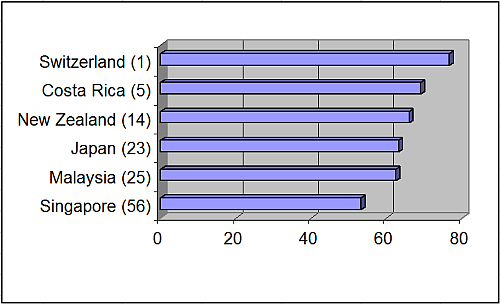The latest Environmental rankings are out. Many of the usual villians have changed little in their rankings, indicating personal pleasure and advancement is over-ruling sensible behaviour. By Jeremy Torr.
Yale University, US. 10 June 2012. Preserving and even enhancing the environment costs money, but, as a recent UN report argues, both can also pay off big-time in terms of improved human health, ecosystem function, and green job growth. Which all provide long-term gains for any economy.
Yale and Columbia Universities, based in the US, decided to see who is doing best at being environmentally responsible. They have produced an Environmental Performance Index (EPI), produced by the universities' researchers since 2000. Which makes us think long-term gains are being sacrificed for immediate satisfaction now. The EPI ranks 132 countries on 22 performance indicators spanning ten policy categories. These cover performance and progress on two broad objectives: environmental health and ecosystem vitality. The index is heavily weighted (70%) towards indicators of ecosystem vitality, with the other 30% determined by environmental health indicators. Categories include the environmental burden of disease; water (effects on human health); air pollution (effects on human health); air pollution (ecosystem effects); water resources (ecosystem effects); biodiversity and habitat; forestry; fisheries; agriculture; and climate change.
Unsurprisingly, Switzerland, with its clean air and lack of heavy industry and pollution, tops Yale's EPI list
As to be expected, the top ten is dominated by European countries with the exception of Costa Rica, a country that has made significant investments in sustainable development and in preserving its natural resources and reducing pollution. Switzerland topped the charts because it “leads the world in addressing pollution control and natural resource management challenges.” France, the UK, and Sweden also made it into the top 10. Asia lags way behind, with Japan best at a lowly 23rd in the league.
The US, which ranked a disappointing 61st in 2010, has crept up to 49th – still appaling for a country with its education and scientific and legal capabilities. Its rankings were dragged down by its near-bottom-of the list performance on climate change, at 121st, despite being top of the list for air pollution control for human health. On water resources, the U.S. ranks a poor 104 out of 132.
Many developing countries are undergoing significant programs of industrialisation that reduce air and water quality, create waste, and negatively impact human health. According to the report, developing countries also face major challenges “associated with poverty and underinvestment in basic environmental amenities, such as access to safe drinking water and basic sanitation.” These countries are under immense pressure to deliver increased standards of living to populations that demand them, while also moving towards more sustainable production processes and consumption patterns.
Poor performing Russia
The EPI also includes a trend report that shows if countries are moving forward or backwards. While most countries are trending positively, not all are. Estonia, Bosnia and Herzegovina, Saudi Arabia, Kuwait, and Russia were countries with the worst negative trends. Russia, at the very bottom of the Trend EPI ranking, has suffered a severe breakdown in environmental health as well as performance declines related to over-fishing and forest loss. It shows declines in every category except for slight improvements in sulfur dioxide emissions, though levels are still far below target. Iraq also continues to rank last as air quality spirals downward and water becomes increasingly scarce.
For the one-third of the planet who live in China and India, the rankings don’t offer good news either. Already, in China, which comes in at 116th place, health experts see air pollution as the greatest threat to public health. Reports indicate that lung cancer rates are two or three times higher in cities than in the countryside, even though smoking rates are the same. Shockingly, India’s air pollution may be even worse; that country comes in at 125th. The OECD estimates that bad air will now kill 3.6 million each year by 2050, with most of those deaths in China and India. Unless those countries’ governments begin to take action and promote and finance a shift to sustainable development, the number of pollution-induced deaths can only increase.
India's atmospheric brown cloud (ABC) dragged its rating down to near the bottom of the league
It's not all bad, however. Belgium and Azerbaijan both shot up the rankings 16% and 12% improvements, as did Gabon and Bulgaria. But despite some of the tiddlers doing their best, the big (bad) polluters continue to dominate, and do their worst. There are now up to 400 parts per million (ppm) of carbon dioxide in the world’s atmosphere, at least in the Arctic. For years, scientists have said 350ppm is really the safe upper-most limit. According to NASA scientists, the planet has not reached 400ppm for at least 800,000 years. Maybe governments in all industrialising countries should be forced to read this report.
For the full results, go to the EPI website: http://epi.yale.edu/dataexplorer/tableofmainresults
Report courtesy ASLA: http://dirt.asla.org


